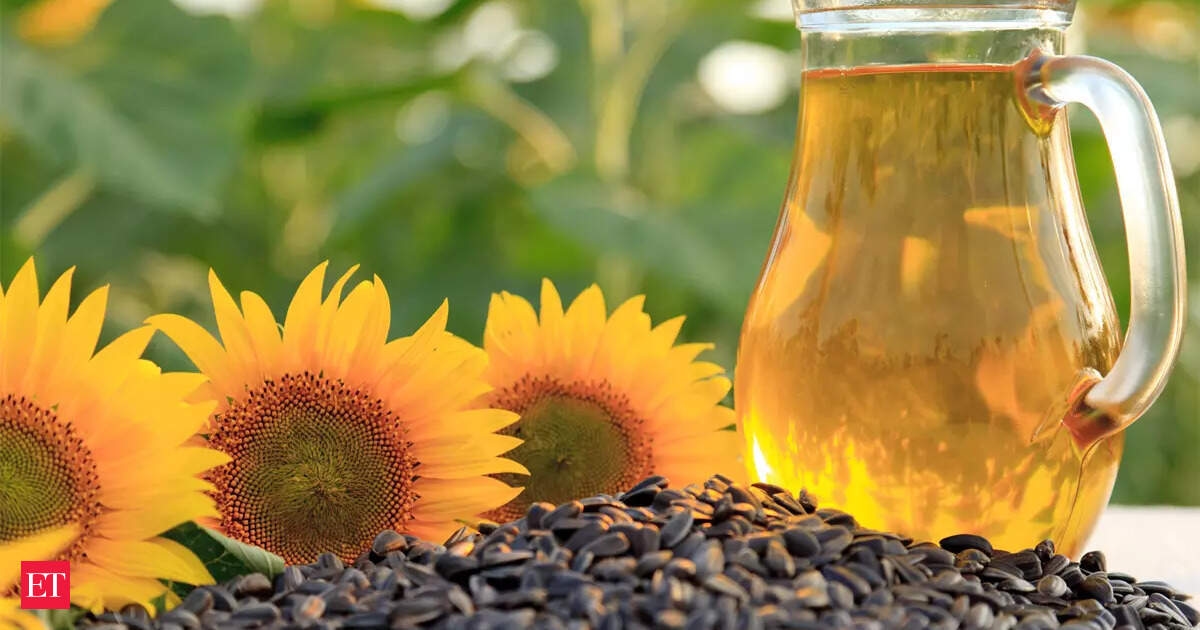Russia overtakes Ukraine as India's top sunflower oil supplier

Russia has been trumping oil exports — and it’s not just crude. Imports of sunflower oil from Russia have shot up twelvefold in the last four years, making it India’s largest supplier, displacing Ukraine.Since the war between Russia and Ukraine began, the latter’s sunflower oil has been diverted largely to Europe, while Russia’s easier and assured access to seaports has made it a more dependable supplier for India, industry insiders said. Industry representatives of Russia and India recently visited each other’s countries to further strengthen the supply chain, they said.Sunflower oil is among the three largest consumed edible oils in India. Less than 5% of the sunflower oil consumed in India is produced locally. “Russia is the largest and most reliable source of sunflower oil in the world. We get advantage of supply chain reliability,” said Sanjeev Asthana, CEO of Patanjali Foods and president of industry body Solvent Extractors’ Association of India (SEA).The share of Russian oil in India’s total sunflower oil imports was around 10% in 2021, which rose to 56% in 2024. India imported 2.09 million tonnes of sunflower oil from Russia in calendar 2024, up 12 times from about 175,000 tonnes in 2021. Competitive Rates?Before the war, Ukraine was India’s largest supplier of sunflower oil. Since then, however, it has had to divert much of its produce to neighbouring European countries by road and rail, as Russia blocked its seaports on the Black Sea — pushing up transport costs sharply for shipments to India. Before the conflict, Ukraine exported close to 90% of its agricultural produce through seaports.Russia had an even bigger crop of sunflowers, which it couldn’t sell to Europe since the start of the war. “They were offering us competitive rates, which is the requirement of the Indian market,” said Sandip Bajoria, president of International Association of Sunflower Oil.India meets nearly 60% of its total cooking oil requirement through imports. While palm oil accounts for nearly 50% of the total cooking oil consumption, soyabean and sunflower oils have the second and third largest share. Indian farmers reduced sowing of sunflower in the 1990s as it no longer remained profitable due to increase in cheaper imports of cooking oils. Sunflower oil imports rose significantly in recent times as it became cheaper than palm oil for the first time ever during 2023 and 2024, industry officials said.“The share of sunflower oil was a distant third after soyabean oil. The Russian supplies have reduced this gap significantly,” Bajoria said. This year, however, sunflower oil imports are expected to fall by about 13% due to a steep price rise. “The overall imports of sunflower oil will decline this year as there is a premium of $150 per tonne on sunflower oil over the palm oil and soyabean oil,” Bajoria said. “However, the share of Russia will remain the same at around 55-60%.” A delegation of SEA visited Russia in September to strengthen the ties.
Competitive Rates?Before the war, Ukraine was India’s largest supplier of sunflower oil. Since then, however, it has had to divert much of its produce to neighbouring European countries by road and rail, as Russia blocked its seaports on the Black Sea — pushing up transport costs sharply for shipments to India. Before the conflict, Ukraine exported close to 90% of its agricultural produce through seaports.Russia had an even bigger crop of sunflowers, which it couldn’t sell to Europe since the start of the war. “They were offering us competitive rates, which is the requirement of the Indian market,” said Sandip Bajoria, president of International Association of Sunflower Oil.India meets nearly 60% of its total cooking oil requirement through imports. While palm oil accounts for nearly 50% of the total cooking oil consumption, soyabean and sunflower oils have the second and third largest share. Indian farmers reduced sowing of sunflower in the 1990s as it no longer remained profitable due to increase in cheaper imports of cooking oils. Sunflower oil imports rose significantly in recent times as it became cheaper than palm oil for the first time ever during 2023 and 2024, industry officials said.“The share of sunflower oil was a distant third after soyabean oil. The Russian supplies have reduced this gap significantly,” Bajoria said. This year, however, sunflower oil imports are expected to fall by about 13% due to a steep price rise. “The overall imports of sunflower oil will decline this year as there is a premium of $150 per tonne on sunflower oil over the palm oil and soyabean oil,” Bajoria said. “However, the share of Russia will remain the same at around 55-60%.” A delegation of SEA visited Russia in September to strengthen the ties.
 Competitive Rates?Before the war, Ukraine was India’s largest supplier of sunflower oil. Since then, however, it has had to divert much of its produce to neighbouring European countries by road and rail, as Russia blocked its seaports on the Black Sea — pushing up transport costs sharply for shipments to India. Before the conflict, Ukraine exported close to 90% of its agricultural produce through seaports.Russia had an even bigger crop of sunflowers, which it couldn’t sell to Europe since the start of the war. “They were offering us competitive rates, which is the requirement of the Indian market,” said Sandip Bajoria, president of International Association of Sunflower Oil.India meets nearly 60% of its total cooking oil requirement through imports. While palm oil accounts for nearly 50% of the total cooking oil consumption, soyabean and sunflower oils have the second and third largest share. Indian farmers reduced sowing of sunflower in the 1990s as it no longer remained profitable due to increase in cheaper imports of cooking oils. Sunflower oil imports rose significantly in recent times as it became cheaper than palm oil for the first time ever during 2023 and 2024, industry officials said.“The share of sunflower oil was a distant third after soyabean oil. The Russian supplies have reduced this gap significantly,” Bajoria said. This year, however, sunflower oil imports are expected to fall by about 13% due to a steep price rise. “The overall imports of sunflower oil will decline this year as there is a premium of $150 per tonne on sunflower oil over the palm oil and soyabean oil,” Bajoria said. “However, the share of Russia will remain the same at around 55-60%.” A delegation of SEA visited Russia in September to strengthen the ties.
Competitive Rates?Before the war, Ukraine was India’s largest supplier of sunflower oil. Since then, however, it has had to divert much of its produce to neighbouring European countries by road and rail, as Russia blocked its seaports on the Black Sea — pushing up transport costs sharply for shipments to India. Before the conflict, Ukraine exported close to 90% of its agricultural produce through seaports.Russia had an even bigger crop of sunflowers, which it couldn’t sell to Europe since the start of the war. “They were offering us competitive rates, which is the requirement of the Indian market,” said Sandip Bajoria, president of International Association of Sunflower Oil.India meets nearly 60% of its total cooking oil requirement through imports. While palm oil accounts for nearly 50% of the total cooking oil consumption, soyabean and sunflower oils have the second and third largest share. Indian farmers reduced sowing of sunflower in the 1990s as it no longer remained profitable due to increase in cheaper imports of cooking oils. Sunflower oil imports rose significantly in recent times as it became cheaper than palm oil for the first time ever during 2023 and 2024, industry officials said.“The share of sunflower oil was a distant third after soyabean oil. The Russian supplies have reduced this gap significantly,” Bajoria said. This year, however, sunflower oil imports are expected to fall by about 13% due to a steep price rise. “The overall imports of sunflower oil will decline this year as there is a premium of $150 per tonne on sunflower oil over the palm oil and soyabean oil,” Bajoria said. “However, the share of Russia will remain the same at around 55-60%.” A delegation of SEA visited Russia in September to strengthen the ties.economictimes





